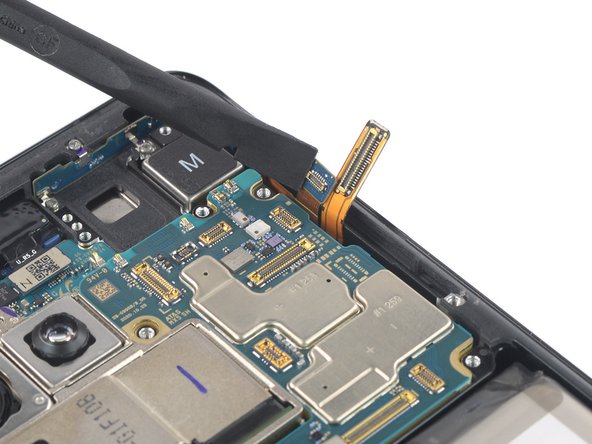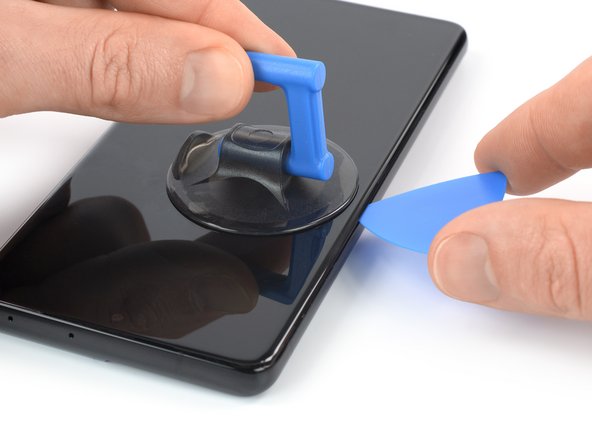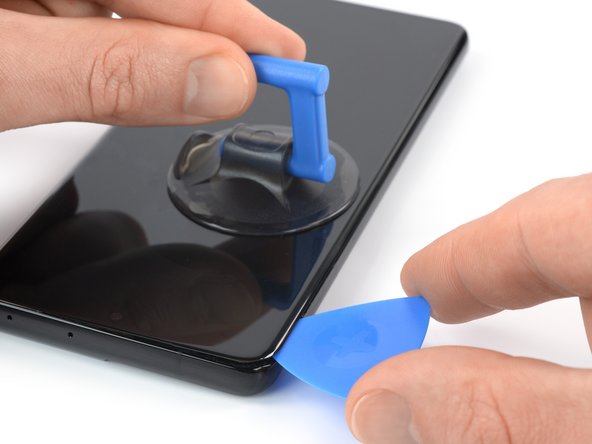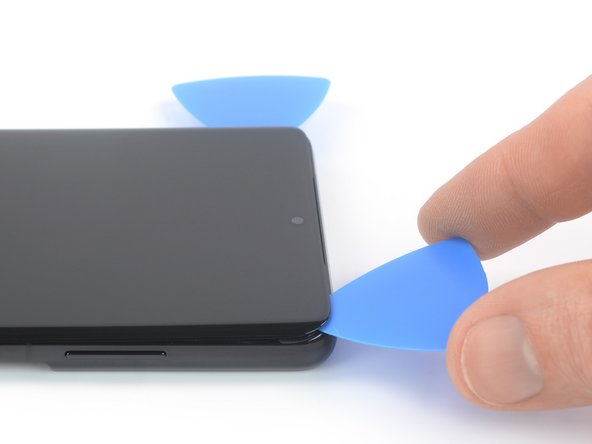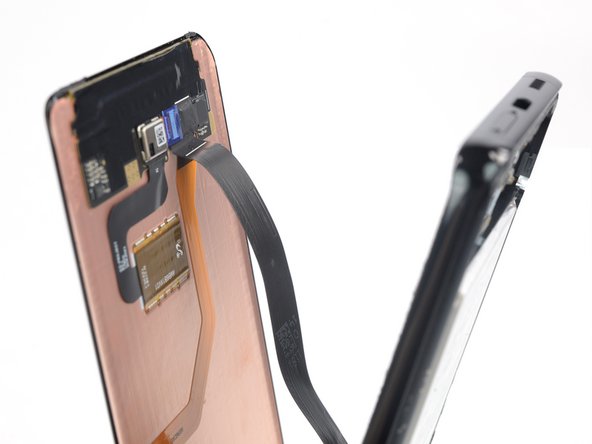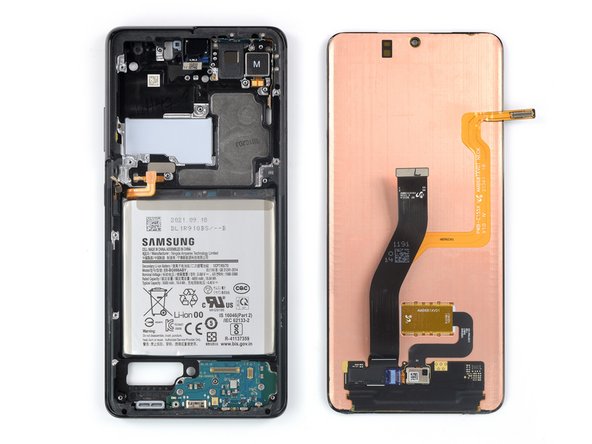Samsung Galaxy S21 Ultra Screen Replacement
Duration: 45 minutes
Steps: 38 Steps
get your battery level down to 25% or lower before you start - it's a safety thing!
Get ready to tackle that cracked or broken screen on your Samsung Galaxy S21 Ultra! We're focusing on the SM-G998B/DS (international) model here, but keep in mind that other models may have an extra antenna cable snuggled in the midframe. If your frame looks a bit bent, it’s best to swap it out to ensure the new screen fits just right and avoids any damage from awkward pressure. And hey, if your battery is looking swollen, take the necessary precautions! Before you dive in, make sure to drop that battery charge below 25% to keep things safe during the repair. Just a heads up: this guide is all about swapping the screen while keeping the original frame and motherboard intact. Some replacement screens come with a brand new frame (or chassis), which means a whole different ball game. So double-check you’ve got the right part before you start! While it’s not essential to remove the interconnect cables for the screen swap, doing so can make motherboard removal and reassembly a breeze. Just a friendly reminder: if you skip replacing the adhesive seals when putting everything back together, your device will still work, but it might lose some of its water protection. Before jumping in, make sure you have a set of replacement adhesives for both the rear glass and the screen. Happy fixing!
Step 1
Before you get started, shut down your phone and unplug it—let’s keep things safe and drama-free.
You can use a hair dryer, heat gun, or hot plate to loosen things up, just don’t go wild with the heat. Your screen and battery appreciate being handled with care!
Step 2
Got a back cover that's more cracked than a sidewalk in summer? Slap on some clear packing tape—this gives your suction cup a fighting chance. Super stubborn? Go with extra-strong tape instead, or if you're really in a bind, superglue that suction cup right onto the cover.
If opening up a gap has you stuck, hit it with a bit more heat to loosen things up. Just make sure to follow the iOpener instructions so you don’t turn your device into a hot potato.
- Stick a suction cup right on the bottom edge of the back cover—snug up against the rim like it’s waiting in line for coffee.
- Give the handle a gentle tug upward to pop a tiny gap between the cover and the frame—think of it as opening a stubborn bag of chips.
- Wiggle an opening pick into that fresh gap like you’re slipping a note through a locker door.
- Slide the pick down to the bottom-left corner, gliding through the adhesive like a DJ scratching vinyl.
- Let the pick chill there like a doorstop so the sticky stuff doesn’t throw the cover back on while you’re not looking.
Tools Used
Step 3
- Slide a second pick in at the bottom edge—your phone’s about to meet its match.
- Glide that pick down to the bottom right corner like you’re carving a Thanksgiving turkey (but with way less drama).
- Park the picks there so the adhesive doesn’t get any funny ideas about resealing itself.
Step 4
If the adhesive is giving you a hard time and feels tough to cut, it probably just needs a little warmth. Grab your iOpener and give it a cozy two to three minutes to heat things up again.
- Pop in a third opening pick at the bottom right corner of your device.
- Gently glide that opening pick along the right edge to cut through the adhesive like a pro.
- Keep the opening pick nestled in the top right corner to stop the adhesive from making a comeback.
Tools Used
Step 5
When you're slicing close to the camera assembly, just slide in the tip of the opening pick (about 4-5 mm) to keep that camera safe and sound—no smudges or damage here!
- Pop a fourth pick under the top right corner, like you’re giving your phone a little haircut.
- Run the pick along the top edge to slice through that sticky adhesive—think of it as opening a stubborn snack bag.
- Let that pick chill in the top left corner so the adhesive doesn’t sneak back together.
Step 6
When you're working near the power button, keep the tip of your opening pick shallow—just about 3-4 mm deep. That way, you’ll steer clear of the flex cable for the power and volume buttons. No cable casualties on your watch!
- Pop in a fifth opening pick right under the top left corner to get things started.
- Gently slide that opening pick along the left edge of the back cover to cut through the last of the adhesive. Keep it smooth and steady!
Step 7
- Time to take off that back cover! Gently remove it and set it aside.
- Now, let's start the reassembly party. Be sure to test your phone before sealing it up. Turn it on and check if everything's working like it should. But don’t forget – power it down completely before getting back to work.
- Any sticky bits left over? Grab some tweezers or just use your fingers to remove those adhesive chunks.
- Got some residue left behind? Take a cotton pad and wipe it off with some high-concentration (over 90%) isopropyl alcohol. That should do the trick.
- Using custom-cut adhesives? Follow this guide and get it just right.
- If you're opting for double-sided tape, follow this guide for a smooth finish.
Step 8
- Slip an opening pick under the left bottom corner of the NFC antenna and charging coil assembly—like you're sliding a secret note.
- Gently glide the pick along the bottom left edge to loosen the assembly from the battery. Smooth moves win the day!
Step 9
- Slide your trusty opening pick right under the bottom edge of that NFC antenna and charging coil assembly. You're doing great!
- Gently glide the pick along the base of the assembly—like butter on warm toast—to free it from its cozy spot next to the loudspeaker.
Step 10
- Grab a spudger and gently work your magic to disconnect that charging coil! Just pry the connector straight up from its cozy socket, and you'll be one step closer to getting everything back in action.
Tools Used
Step 11
- Grab your trusty spudger and gently pry the NFC antenna connector straight up from its socket. You got this!
Tools Used
Step 12
- Grab a Phillips screwdriver and unscrew the five 3.9 mm-long screws holding down the NFC antenna and charging coil assembly. Easy does it—just a few turns to free that part up. If you hit any snags, remember, you can always schedule a repair with Salvation Repair for a hand.
Step 13
- Gently lift out the NFC antenna and charging coil assembly using tweezers or your fingers. Easy does it—no need to rush!
Step 14
- Grab your trusty spudger and gently pry the battery cable connector upwards straight from its socket. You're doing great!
Tools Used
Step 15
- Grab your trusty Phillips screwdriver and get ready to tackle those four 3.9 mm-long screws holding the loudspeaker assembly in place. You've got this!
Step 16
- Slip your spudger into the gap at the top edge of the loudspeaker assembly, right where it meets the midframe.
- Gently pry the loudspeaker assembly upward by tilting your spudger downward. Go slow—no need to rush!
Tools Used
Step 17
- Take out the loudspeaker assembly. When putting things back together, make sure to add fresh adhesive where needed after giving the area a good clean with isopropyl alcohol (>90%). If you need a hand, you can always schedule a repair.
Step 18
If you're not looking to dive into the motherboard or swap out the battery, feel free to breeze past this step and jump right into the next one!
- Grab a spudger and gently pry up the display flex cable connector straight from its socket. Easy does it—no force needed!
Tools Used
Step 19
- Grab your trusty spudger and gently pop the main and interconnect flex cables loose from the motherboard by lifting their connectors straight up. Easy does it—you're just giving them a little nudge out of their sockets!
Tools Used
Step 20
- Grab your trusty spudger and gently pry the interconnect flex cable off the daughterboard. Just lift that bottom connector straight up from its socket like it's taking a little stretch break.
- Now, it’s time to delicately coax that interconnect flex cable out of its home using your fingers or a pair of tweezers. Easy does it!
Tools Used
Step 21
- Grab your trusty spudger and gently pry the bottom connector of the main flex cable straight up from its socket to disconnect it from the daughterboard. Easy peasy!
- Now, with a little finesse, use your fingers or a pair of tweezers to carefully lift out the main flex cable. You've got this!
Tools Used
Step 22
- Grab your trusty Phillips screwdriver and get ready to tackle those four 3.9 mm-long screws that are holding the earpiece speaker and laser AF module assembly in place. You've got this!
Step 23
- Grab your trusty spudger and gently pop up the connectors for the laser AF module and the earpiece speaker flex cables. Just lift them straight out of their sockets—no wrestling required!
Tools Used
Step 24
- With a pair of blunt nose tweezers in hand, gently grasp the bottom right corner of the earpiece speaker and laser AF module assembly, and lift it up with care.
- Now, go ahead and remove the earpiece speaker and laser AF module assembly. You've got this!
Step 25
Give those cables a gentle curve—no sharp folds! Treat them kindly to keep them working like champs.
- Grab your trusty spudger and gently nudge those in-display fingerprint and antenna flex cables by lifting the connectors straight up from their cozy little sockets.
- With a touch of care, slightly bend both connectors to the side to set the motherboard free. You're doing great!
Tools Used
Step 26
- Grab your trusty spudger and gently lift the front facing camera cable connector straight up from its socket. Easy does it!
Tools Used
Step 27
- Grab your trusty spudger and gently pop the power button flex cable connector straight up from its cozy spot.
- Give the connector a gentle nudge to the side so the motherboard has some wiggle room.
Tools Used
Step 28
- Let's get started! Use a Phillips screwdriver to carefully remove the 3.9 mm-long screw that's holding the camera module in place.
Step 29
Be gentle with those ribbon-like flex cables cuddling the motherboard—they bruise easily, so no yanking, k?
- Slide a spudger underneath the top edge of the motherboard, right next to the vibration motor. You've got this!
- Now, use your trusty spudger to gently lift the motherboard by tilting it downwards and giving it a little twist to the side. Easy peasy!
Tools Used
Step 30
Be gentle and take your time when removing parts, making sure those flex cables aren't tangled up in the motherboard - we don't want any accidental tears!
- Gently lift out the motherboard, making sure to keep everything steady. If you need a hand or want to get it done right, you can always schedule a repair.
Step 31
The Galaxy S21 Ultra's display adhesive is no joke – it's pretty tough! You'll probably need to give your iOpener a few rounds of reheating and reapplication before and during the display removal process. Be patient, it’ll be worth it!
If you’re not a fan of the iOpener, you can always try a hair dryer, heat gun, or hot plate. Just keep an eye on the temperature so you don’t accidentally cook your device!
Step 32
Stick to using just the tip of the opening pick (about 4-5 mm) here—going deeper risks catching the fingerprint cable or giving it an accidental rip. Easy does it!
If your screen is sporting some serious cracks, slapping on a layer of clear packing tape might just do the trick to help that suction cup stick! If you're feeling adventurous, you can also try using some super strong tape instead of the suction handle. And if you're really in a bind, a little superglue on the suction cup can work wonders to keep it in place on the screen. You've got this!
- Once the screen is nice and warm to the touch, stick a suction handle onto the left edge of the display, getting as close to the edge as you can. Gently lift with the suction handle to create a tiny gap between the screen and the frame. Next, slide an opening pick into that gap between the midframe and the display. Carefully guide the pick up towards the top left corner to cut through the adhesive holding everything in place. Keep that opening pick in position to stop the adhesive from sealing back up as you work. If you need a hand, you can always schedule a repair.
Tools Used
Step 33
- Slide a second opening pick into the top left corner and gently glide it down to the bottom left corner of the screen to cut through that pesky adhesive.
- Keep that opening pick snugly in place to stop the adhesive from sticking back together.
Step 34
When you're working near the front facing camera, just dip the tip of the opening pick in—keep it to about 2-3 mm. That way, your camera stays free from smudges and damage!
- Pop a third pick into the top left corner of the screen—like adding another friend to the party.
- Glide that pick along the top edge to break up the sticky adhesive. Smooth moves only.
- Let the pick hang out there to keep the glue from sneaking back together. Prevention is key!
Step 35
If the adhesive gets stubborn and resists cutting, chances are it’s cooled off. Warm it back up with your iOpener or heat gun for about 1-2 minutes, and it’ll soften right up—smooth sailing from there.
- Pop a fourth opening pick right under that top right corner of your screen. You've got this!
- Gently slide the opening pick down the right edge to cut through the adhesive like a pro.
- Keep that opening pick in place to stop the adhesive from sealing back up. You're on a roll!
Step 36
Hold your horses! Don't yank that display out just yet. The display and fingerprint cable are still snugly tucked through the frame.
- Pop the fifth pick into the lower-right corner like you're sneaking the last cookie into the jar.
- Slide that pick along the bottom edge and give the leftover glue a friendly wave goodbye.
Step 37
- Gently guide the fingerprint flex cable through the slot in the midframe—think of it as threading a needle, but with way cooler tech.
Step 38
- If you can, power up your device and give your repair a quick test drive before you seal everything up with new adhesive.
- Time to put Humpty Dumpty back together again! Just retrace your steps using these instructions in reverse order.
- Once you've wrapped up the repair, follow this guide to ensure everything's working like a charm.
- For a snug fit, the best trick is to use a custom-cut sheet of double-sided tape on the back of your new screen.
- Got some e-waste? Make sure to drop it off at an R2 or e-Stewards certified recycler.
- Things didn't go as smoothly as you'd hoped? No worries! Try some basic troubleshooting or feel free to reach out to our community for support. And remember, if the going gets tough, you can always schedule a repair.






























































